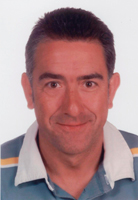


Alberto Errazti Igartua was born on 10 June 1961 in Arrasate-Mondragón to a Basque-speaking family. His father, Félix, was from the Markitegi farmhouse in Aretxabaleta, and his mother, Juanita, who lives in Bilbao, from the Uribarri district in Oñati. The third of five siblings, after having spent the first nine years of his life in his home village, he moved with his family to Bilbao. In 1985 he graduated in Basque at the University of Deusto and married in Durango. Father of Eneko and Asier, born from his relationship with M. Carmen Txintxurreta, today he teaches Basque language and literature at the Fray Juan de Zumárraga College in Durango.
Since the 80s he has carried out several kinds of work for the University of Deusto. While studying, he taught Basque to Basque teachers; however, his most important contribution lies in the field of toponymy. A tireless collaborator with the DEIKER institute, Alberto has proven his experience in various projects: supervision of the Recopilación toponímica de Bizkaia en escala cartográfica 1:5.000 (Collection of toponyms in Bizkaia in cartographic scale 1:5000) in 1989; research fieldwork for the Recopilación toponímica de Araba y Gipuzkoa en escala cartográfica 1:5.000 (same as above, but for Araba and Gipuzkoa), specifically in the Alavese towns of Asperrena, Barrundia, Donemiliaga and Zalduondo, and in the Entzia mountain range in 1991/92. He also did fieldwork in several towns in the Duranguesado region (Durango, Garai, Iurreta, Itzurtza, Mañaria and Zaldibar) for the Recopilación toponímica de Bizkaia en escala cartográfica 1:5.000 in 2001/02.
As far as articles and books published are concerned, his work has always had a great deal of space for research work and its diffusion for a wide spectrum of readers: starting in his home town, among others, he wrote the column bertako hizkera (speak local) published in the Duranguesado weekly, ERAZ, plus articles on local place names and mountain excursions in the Katazka magazine published by the Club Alpino Tabira in Durango. He was also the editor of this publication from 1997-1999 alongside Rosa Lejardi. Meanwhile, for years he has continued to tackle the challenge of publishing books, having brought out the following:
He also contributed his grain of sand to developing the media in Euskera, specifically in Bidaide, Gogaide sections (26 articles on mountains) and the Mundu mira supplement (20 articles on mountains) of Euskaldunon Egunkaria, until it was violently closed down by the Civil Guard in 1995; he later wrote in the Harat-honat, Tartea and Plaza sections (25 articles on mountains) of the daily, Berria. In 2006 he lept into the airwaves, participating in the programme Faktoria on Euskadi Irratia, informing for 2 years on the mountains of Bizkaia and their hidden treasures.
Recent years have seen him fervently participate in several programmes focussed on encouraging the enjoyment of culture amoung young people. In 2010, for example, he organised the route Sarriren memoriaren mapa (Sarrionandia memory map) as part of the Zilar Astea programmed by the Plateruena Kafe Antzoki: the perfect cherry on the cake were the five years he was president of the same Kafe Antzoki, although today he continues to back the project as a partner and contributor.
Here you can see the study of the toponymy of the town of Durango. This is a new challenge in his already lengthy and prolific career, given that it dispenses with traditional backing to take the shape of direct publishing on a website. There are three reasons for this change: on the one hand, the research work is offered to all those who wish to study it; on the other, it uses new technologies to favour exchange between the author of the study and those interested in reading it; and, finally, it offers new channels for recovering the names of places in danger of disappearing or suffering deformation.
30 June 2011
1 Was published that same year for the Basque Book and Record Fair in Durango. Its launch was attended by: Xebe Peña, Javier Pascual (ediciones Sua) and the author.
2 Was published that same year for the Basque Book and Record Fair in Durango. Its launch was attended by: Alfonso Irigoien, Juan Manuel Etxebarria, Anton Mari Aldekoa-Otalora (municipal representative) and the author.
3 Work of several authors: Xabier Aranguren, Joxean Gil-Garcia, Allande Sokarros, Alberto Errazti, Koldo Aldaz, Arratiako Laratzu taldea, Mikel Arrizabalaga and Xabier Lasa.
4 Was launched the same year at the Zaldibar Town Hall. With the participation of: Jose Luis Lizundia (Euskaltzaindia), Patxi Goenaga (Basque Government), Gotzon Lobera (Provincial Council of Bizkaia), Igor Barrenetxea-Arando (Mayor) and the author.
